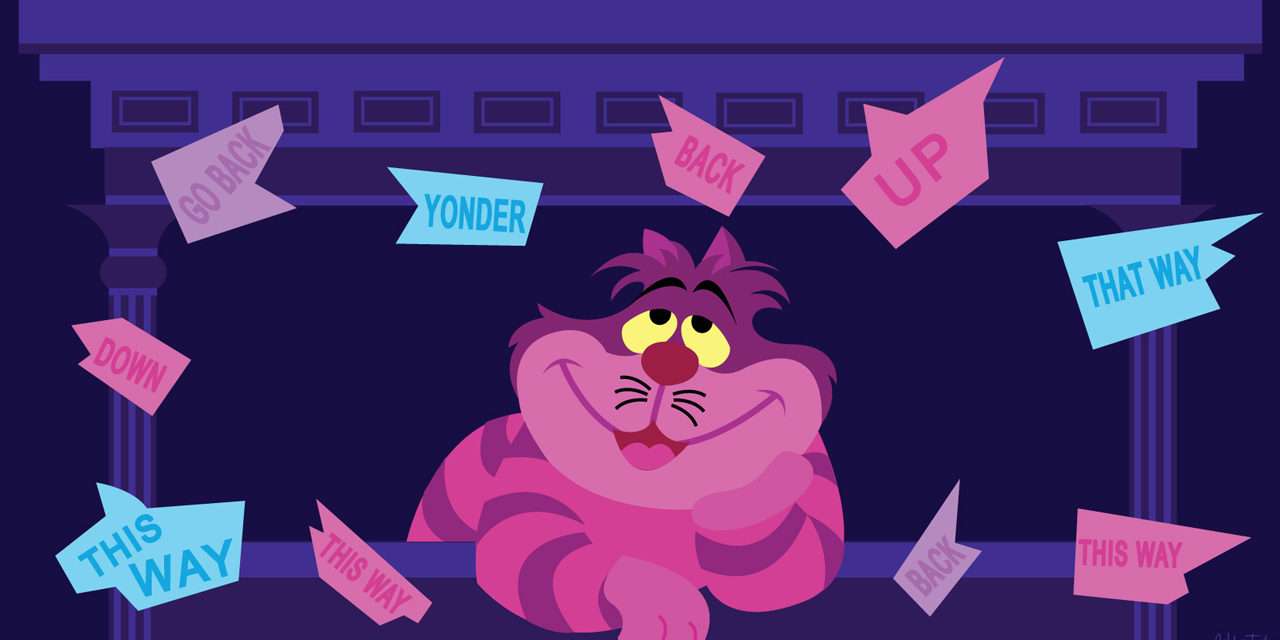As part of an initial effort at supporting course design here at Pennsylvania College of Art & Design, I’m sharing a version of the 3-day layout through the blog. Course design institutes are often multi-day events that focus on a backward design process: identifying goals, aligning your assignments/assessments with these goals, and formulating your day-to-day teaching to align with your goals and assessments. Straightforward, right? I have facilitated a version of this for years, and I can say that it benefits many … but I also think it leaves important considerations out of the design process … unless we intentionally center them. In part 1, we consider how the concept of learning objectives can constrain our thinking about the goals we have for students.
“One day Alice came to a fork in the road and saw a Cheshire cat in a tree. ‘Which road do I take?’ she asked. ‘Where do you want to go?’ was his response. ‘I don’t know,’ Alice answered. ‘Then,’ said the cat, ‘it doesn’t matter.” ― Lewis Carroll, Alice in Wonderland
Some of us have seen the above quote from Alice in Wonderland attached to discussions of goal setting. Without a goal, does it matter where you go? Course design often begins with a consideration of the learning goals you have for your students, usually framed in the language of learning objectives (“By the end of this course, students will be able to…”). I think objectives can be helpful, but we often stop here. At the same time, we often have other goals for students that remain implicit (we want students to become critical thinkers, gain an appreciation for other perspectives, etc.). Rather than leaving these outside of the scope of our goal setting for course design, I want to include these in a big ‘pile’ of goals we have for our students, understanding that we may need to choose which ones to prioritize. The process of deciding which of our content objectives are nonnegotiable is balanced with the weighing which of our ‘intangible’ objectives are nonnegotiable.
Brief aside: But, you might be asking yourself, how do we ASSESS these intangible objectives? That’s a great question! This is what discussion with your colleagues and others can help you consider. I make no pretense to perfect/easy answers to these questions, which is probably why many of us shy away from non-content objectives.
One instructor I’ve spoken with at PCAD has indicated their desire for students to be risk takers. While we can think of achieving this goal through verbal encouragement (“Go big or go home!”), how is the goal/value reinforced (or undermined) through other aspects of our course/teaching? How does our grading not penalize initial attempts that, while missing out on an objective, indicate an honest attempt that can be iterated with constructive critique? When we articulate an objective, be it a content-related one or a more intangible one like risk taking, there’s bound to be more than one way to go about it. We could design assignments that ask students to intentionally try something in multiple ways, or to try a technique/approach that is new to them, etc. We can make it clear that they’re not being evaluated for their ability to be perfect from the getgo, but you’re recognizing that quantity and quality are both important in creativity.
Questions to consider: While you might be clear on your content related goals for your course, what other goals do you have for your students?
- What do you want students to appreciate? What attitudes do you want them to develop? What habits?
- How do you want them to relate their artmaking to the ‘outside/real world’? Do you want them to make art that addresses current events?
- How do you want them to grow in the critique process? How do you want them to give and receive feedback? (I’ve heard many faculty share these goals, but we don’t often make them explicit).
Once we’ve formulated goals and objectives, considered assessments, and sussed out our daily teaching approaches, we can combine these ingredients into a course map. Traditionally, mapping a course looks a lot like organizing a spreadsheet: how does x align with y, and so on? This work is valuable, and I think mapping can be a great way to organize your thinking. At the same time, the idea of creating a map of our course opens the door for creative thinking. Within the context of a Course Design Academy I helped facilitate at Penn State, a course map took on the character of a visual representation of your course, illustrating the student path and/or experience through the course (and the relationships between various elements of the course).
For example, one instructor I worked with was designing a mathematics course for first-year students, with an emphasis on practical applications of math. This was not just to vouch for the real-world value of mathematics (though this was part of it), but also to stimulate their thinking about future courses, potential majors, and possible careers. In talking about metaphors for her class, she arrived at the idea of an interactive museum exhibit, with hands-on opportunities for visitors. As the tour guide, the instructor was there to answer questions, yes, but also to connect students with possible interests. Drawing up a course map of an interactive museum exhibit flowed easily from this discussion, and this vision for her course helped shape a number of decisions that would’ve felt more abstract with a spreadsheet approach.
To get started on this mapping, it can be helpful to engage in some analogical thinking. Using metaphors/analogies for our classes can help us find new ways of expressing what otherwise would be listed as content-related learning objectives. For the instructor in the example above, that meant thinking about the purpose for introducing students to a wide range of mathematics.
- Start with a stem: “Learning in this course is like…” or “Learning (subject) is like …”
- Consider both how the analogy works, and maybe where it begins to break down. This can help you refine it.
- Try your analogy with someone who is NOT in your discipline. This will challenge you to avoid speaking of your subject in your own jargon. (Source: Decoding the Disciplines)
- When you start to feel comfortable with a metaphor/analogy, see how it might play out in terms of goals you have for the course. Consider adding this language to your syllabus to give your students a transparent introduction to what your course is all about! Again, the instructor above used this museum metaphor to lower pressure for her students in math: “This isn’t about math being abstract,” she might say, “This course is about seeing the ways in which math is a part of so many jobs/careers that might interest you… Let’s discover this together!” It was an invitation.
In summary, thinking about your learning objectives includes content, but a holistic approach to course design includes surfacing your additional goals. It’s an invitation to consider the ways you hope your students will grow. Beyond content, it’s a change to consider what you REALLY want them to remember.



